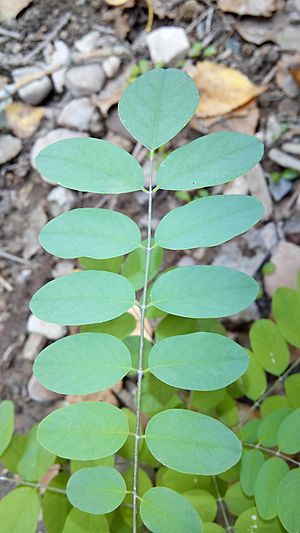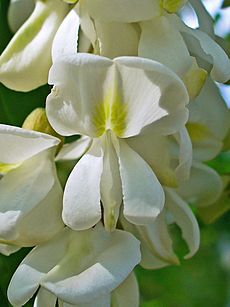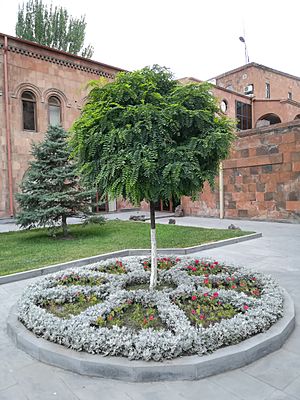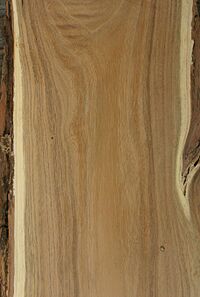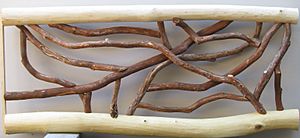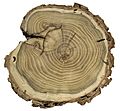Black locust facts for kids
Quick facts for kids Black locust |
|
|---|---|
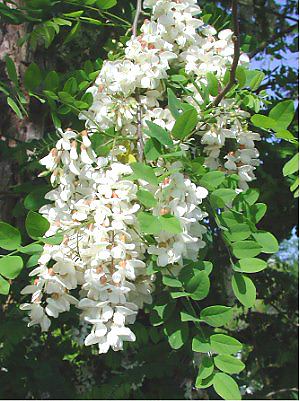 |
|
| Flowers | |
| Conservation status | |
| Scientific classification | |
| Genus: |
Robinia
|
| Species: |
pseudoacacia
|
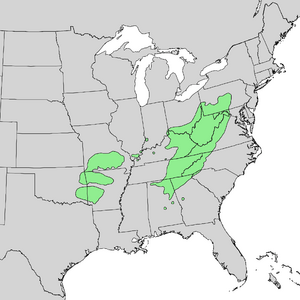 |
|
| Native range | |
The Black Locust (scientific name: Robinia pseudoacacia) is a medium-sized tree with hard wood. It loses its leaves every year (that's what deciduous means!). This tree originally comes from a few small areas in the United States. However, people have planted it widely in many other places like North America, Europe, Southern Africa, and Asia. In some of these areas, it is now considered an invasive species, meaning it can spread too much and harm local plants.
Another common name for this tree is false acacia. This name comes from its scientific name, where "pseudo" means fake or false, and "acacia" refers to another group of trees called acacia.
Contents
What is a Black Locust?
The black locust is a plant that belongs to the legume family, also known as Fabaceae. This means it's related to plants like peas and beans! It's part of a group called Faboideae.
People often call the black locust "false acacia" because its scientific name is pseudoacacia. Even though it looks a bit like the true acacia tree (which has similar feathery leaves and thorns), they are not very closely related. Their flowers look quite different. You usually won't confuse them in cooler places because acacias grow in warmer, tropical areas, while black locusts prefer cooler climates.
History of the Black Locust
British settlers first found the black locust tree in 1607 in Jamestown, Virginia. They used its strong wood to build houses. The tree was named "locust" because it looked similar to a tree from the "Old World" called Ceratonia siliqua.
Some people mistakenly thought this was the tree that helped St. John in the wilderness, but the black locust only grows naturally in North America. The tree was brought to Britain in 1636.
Even though Robinia trees are native to North America, scientists have found traces of them in very old rocks in Europe. This shows they have a long history!
Where Black Locusts Grow
The black locust naturally grows in the eastern United States. However, because people have planted it so much, you can now find it all over North America, including most of the U.S. states and parts of Canada.
Scientists believe its original home was in two main areas: one around the Appalachian Mountains (from Pennsylvania to northern Georgia) and another further west around the Ozark Plateau and Ouachita Mountains (in Arkansas, Oklahoma, and Missouri).
Today, the black locust has spread even further, thanks to humans. You can find it in places like Pakistan, India, Australia, China, Europe, and parts of Africa and New Zealand.
Black Locust as an Invasive Species
The black locust is an interesting example of a plant that can be invasive even in its home continent. For instance, in the western United States, New England, northern California, and the Midwest, it's considered an invasive species.
In grassy areas like prairies and savannas in the Midwest, the black locust can take over. It grows tall and shades out the native grasses, turning grasslands into forests. This is a problem because these grassland ecosystems are shrinking. When black locust invades, it changes the whole environment. Because of this, it's listed as invasive in Connecticut and Wisconsin, and it's even banned in Massachusetts.
In Australia, the black locust has spread naturally in several states and is seen as an environmental weed. In South Africa, it's also considered a weed because it sends out many new shoots from its roots.
What the Black Locust Looks Like
Black locust trees usually grow to be about 40 to 100 feet (12 to 30 meters) tall, with a trunk about 2 to 4 feet (0.6 to 1.2 meters) wide. Very old trees can even reach 170 feet (52 meters) tall! It's a very straight tree with a narrow top, which can look a bit messy as it gets older.
Its leaves are dark blue-green on top and lighter underneath. This gives the tree a beautiful look when the wind blows.
Black locust trees need a lot of sunlight and don't grow well in shade. They often grow in young forests or disturbed areas where there's plenty of sun and dry soil. Because of this, they can sometimes act like a "weed tree." They also spread easily by sending up new shoots from their underground roots.
Young trees often have sharp spines, but older trees usually don't. In early summer, the black locust blooms with large, very sweet-smelling flowers that look like orange blossoms. These flowers grow in big clusters. The leaves of the black locust, like other legume plants, fold together when it's wet or at night.
The black locust looks a bit like the honey locust, but it doesn't have the long, branched thorns on its trunk. Instead, it has short pairs of prickles at the base of each leaf. Its leaflets are also wider than those of the honey locust.
Detailed Features
- The bark is reddish-black and gray, with hints of red or orange in its deep grooves. These grooves run up and down the trunk, often crossing to form diamond shapes.
- The roots of the black locust have special bumps called nodules. These nodules help the tree take nitrogen from the air and put it into the soil, which is common for plants in the pea family. This process is called nitrogen fixation.
- The branches often grow in a zig-zag pattern. When they are young, they are covered in soft white fuzz, which soon disappears, leaving them pale green or reddish-brown.
- Spines may or may not be on young trees or new shoots from the roots. Branches high up on the tree usually don't have spines. The number of spines can vary a lot from tree to tree. These spines grow from small leaf-like parts called stipules, so they appear in pairs at the base of the leaves. They are about 0.25 to 0.8 inches (0.6 to 2 cm) long, somewhat triangular, and dark purple. They stay on the tree until the thin young bark they're attached to is replaced by thicker, older bark.
- The wood is pale yellowish-brown, heavy, hard, strong, and very good at resisting rot, especially when it's in contact with the ground.
- The leaves are compound, meaning each leaf is made up of many smaller leaf-like parts called leaflets. These leaflets are usually paired along a central stem. There's often one leaflet at the very tip. Each leaf is 6 to 14 inches (15 to 35 cm) long and has 9 to 19 leaflets. Each leaflet is about 1 to 2 inches (2.5 to 5 cm) long and 0.25 to 0.75 inches (0.6 to 1.9 cm) wide. The leaves appear quite late in the spring.
- The leaf color of fully grown leaves is a dull dark green on top and paler underneath. In the fall, the leaves turn a clear pale yellow.
- The flowers open in May or June and last for about 7 to 10 days, after the leaves have grown. They hang in loose, drooping clusters called racemes, which are usually 4 to 8 inches (10 to 20 cm) long. The flowers are creamy-white (sometimes pink or purple) with a pale yellow spot in the center. They are about 1 inch (2.5 cm) wide, very fragrant, and produce a lot of sweet nectar. Each flower has both male and female parts.
- The fruit is a flat, smooth, pea-like pod, about 2 to 4 inches (5 to 10 cm) long and 0.5 inches (1.2 cm) wide. Each pod usually contains 4 to 8 seeds. The seeds are dark orange-brown with irregular marks. They ripen in late autumn and stay on the branches until early spring.
- Winter buds: The tiny buds are hidden in a small dip and are covered by the swollen base of the leaf stem. They open in early spring.
Black Locust Reproduction and Life Cycle
Black locust trees can reproduce in two ways: sexually, using flowers and seeds, and asexually, by growing new shoots from their roots.
Insects, especially bees, pollinate the flowers. The way the flower is built usually prevents it from pollinating itself. The seeds grow quickly, but they have a tough outer coat, so not all of them will sprout. If the seed coat is softened (for example, with hot water), more seeds will grow. The tree produces many seeds every year or every other year.
New shoots, called suckers, growing from the roots are an important way this tree spreads locally. These suckers can grow into full trees, even if the roots are damaged (like by a lawn mower). If the main trunk is cut down, it can also sprout new growth. This makes it hard to remove black locust trees because you have to keep removing the suckers from both the trunk and the roots, or the tree will just grow back. This is a form of asexual reproduction.
These suckers allow black locust to form dense groups that can block out other plant species. These thickets can shade out other plants, preventing them from growing.
How Humans Spread Black Locusts
Humans have helped spread the black locust tree because it grows fast and is very tough. It's often used to help control soil erosion. Its wood is considered one of the strongest in North America, which made people want to plant it in new areas to harvest the wood.
Black Locust in Nature
When black locust grows in sandy areas, it can make the soil richer by adding nitrogen through its root nodules. This helps other plants grow there too.
The black locust is a "pioneer species," meaning it's one of the first plants to grow in disturbed areas or at the edges of forests. It loves bright sunlight and doesn't do well in shade. It prefers dry to moist soils, especially those with limestone, but it can grow in most soils as long as they aren't too wet. Over time, taller or more shade-tolerant trees might replace it.
The black locust isn't the most important plant for wildlife, but it does provide good cover in open areas. Its seeds are eaten by birds like bobwhite quail and by squirrels. Woodpeckers might also nest in older trees because they often get a type of rot inside their trunks.
Pests of the Black Locust
Some insects can harm the black locust tree:
- The locust leaf miner turns the leaves brown by mid-summer. It slows the tree's growth but doesn't usually kill it.
- The locust borer is a beetle whose larvae dig tunnels inside the tree's trunk. This makes the tree weaker and more likely to be blown down by wind.
- Heart rot is the only serious disease that affects black locust.
- A virus called Chlorogenus robiniae can cause strange growths called "witch's broom" on the tree.
Uses of the Black Locust
Growing Black Locusts
The black locust is a very important plant for honeybees in the eastern U.S. It has also been planted in European countries, where it's the source of famous "acacia honey." The flowers bloom for a short time (about 10 days) and don't always produce a lot of honey every year.
It's easy to grow new black locust trees from roots or cuttings. This makes it simple to reproduce the plant. Special types of black locust (called cultivars) can also be grown by grafting, which ensures the new plant is exactly like the parent.
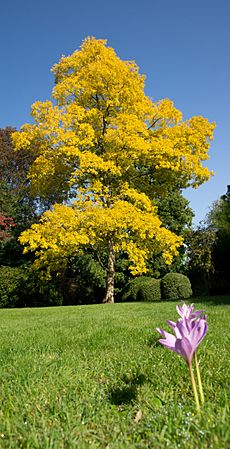
The black locust is great for planting in areas where the ground has been disturbed, like construction sites, to help stop soil erosion. Its shallow, strong roots help hold the soil in place. The tree grows quickly even in poor soils because it can add nitrogen to the ground.
Since the cost of fertilizers is going up, the black locust's ability to fix nitrogen is becoming more important for farming and forestry.
Black locust is also planted for firewood. It grows fast, is tough, and grows back quickly from its stump after being cut down (a method called coppicing).
In Europe, it's often planted along streets and in parks, especially in big cities, because it can handle pollution well.
Special Types of Black Locust (Cultivars)
There are several special types of black locust trees, but 'Frisia' is one of the most popular.
- ‘Frisia’ has bright yellow-green leaves and red prickles. It's often planted just for its beautiful looks.
- ‘Purple robe’ has dark rose-pink flowers and new leaves that are bronze-red. Its flowers tend to last longer than those of the wild tree.
- ‘Tortuosa’ is a smaller tree with twisted and bent branches.
Black Locust Wood
The wood of the black locust is extremely hard, one of the hardest in North America. It's very good at resisting rot and lasts a long time. This makes it valuable for furniture, flooring, fences, and small boats. Black locust wood is a natural product that doesn't need chemicals to stay beautiful for over 50 years. Freshly cut wood can have a strong smell, but it goes away as the wood dries.
In some parts of Europe, black locust is one of the most rot-resistant local trees. People are planting more of it to reduce the need for tropical wood. Special chemicals in the wood help it last over 100 years in the soil!
Black locust is also highly valued as firewood for wood stoves. It burns slowly with little smoke and gives off more heat than most other trees in the Eastern United States, similar to a type of coal called anthracite. It's popular because it can even burn when wet. However, if the wood has knots or beetle damage, it can sometimes "spit" hot coals in a fireplace.
Around 1900, the value of black locust wood was greatly reduced in many parts of the U.S. because of the locust borers. These insects tunnel into the trunk and branches, making the wood less useful. Without these insects, it would be one of the most valuable timber trees to plant. Young trees grow fast, but they often become stunted and diseased, and don't live long enough to be used for commercial timber.
Food and Medicine
In traditional medicine in India, different parts of the black locust tree are used as a laxative (to help with digestion), an antispasmodic (to reduce muscle spasms), and a diuretic (to help the body get rid of extra water).
In Romania, the flowers are sometimes used to make a sweet, fragrant jam. People carefully pick the flowers, remove the seeds, and boil the petals with sugar to create a light, delicate jam.
Even though the bark and leaves are poisonous, some reports say that the seeds and young pods of the black locust can be eaten. The shelled seeds are safe to gather from summer through fall and can be eaten raw or boiled. However, the seeds are small, so shelling them can be tricky. In France, Italy, and Romania, black locust flowers are dipped in batter and fried, like beignets. They are also eaten in Japan, often as tempura.
Is Black Locust Poisonous?
Yes, the bark, leaves, and wood of the black locust tree are poisonous to both humans and animals. The plant contains a harmful substance called robin, which loses its toxicity when heated.
Horses that eat the plant can show signs of not wanting to eat, feeling sad, losing control of their bowels, having stomach pain, feeling weak, and having an irregular heartbeat. These signs usually appear about an hour after eating the plant, and the animal needs immediate help from a vet.
Images for kids
See also
 In Spanish: Robinia pseudoacacia para niños
In Spanish: Robinia pseudoacacia para niños





